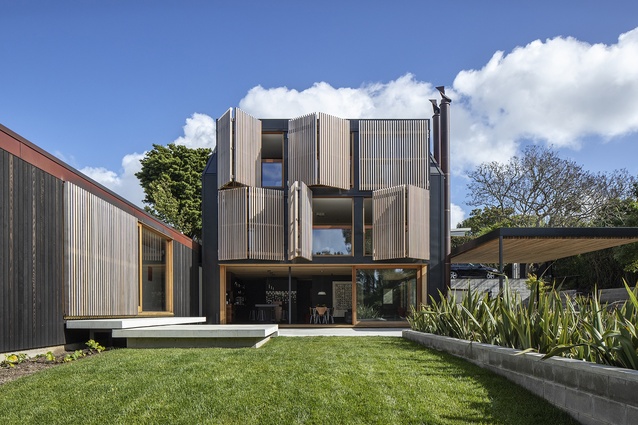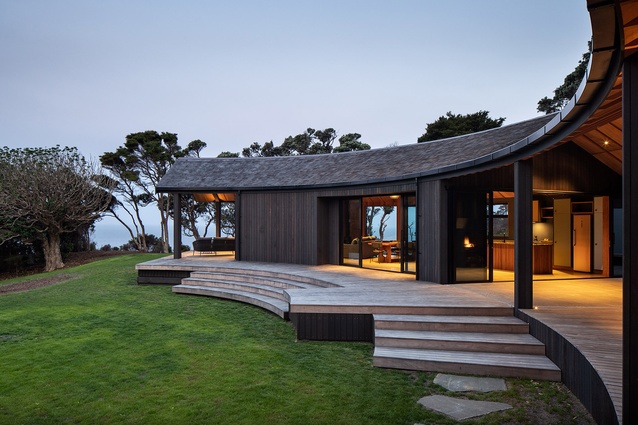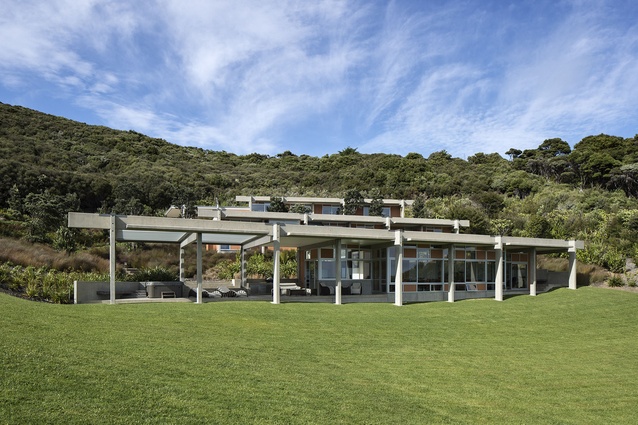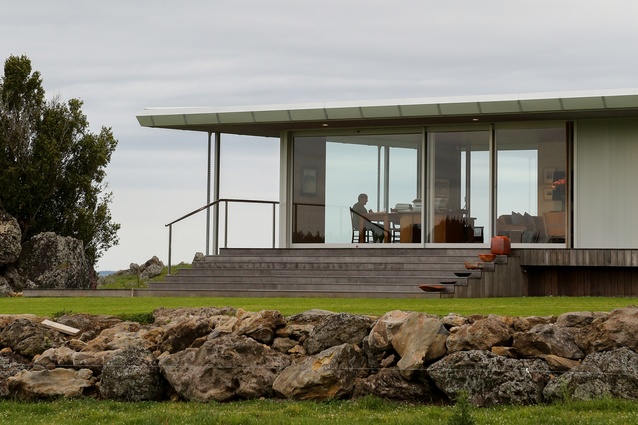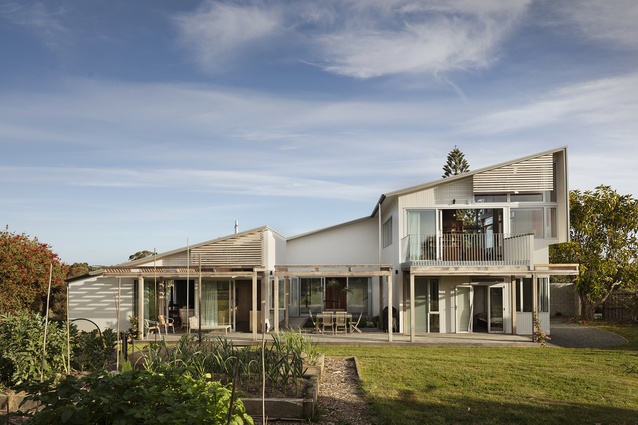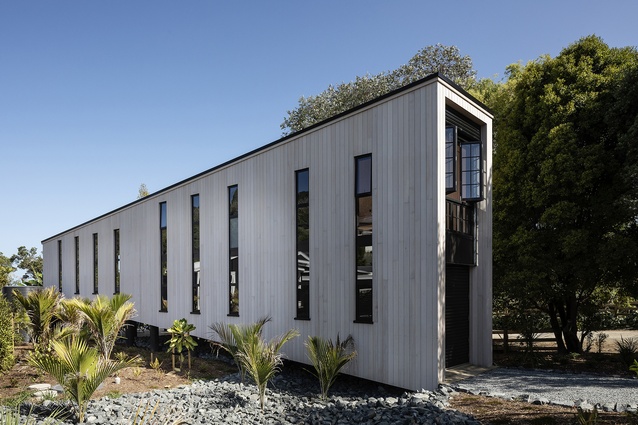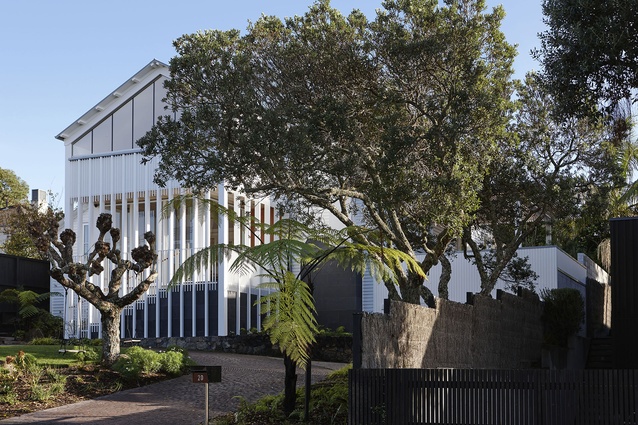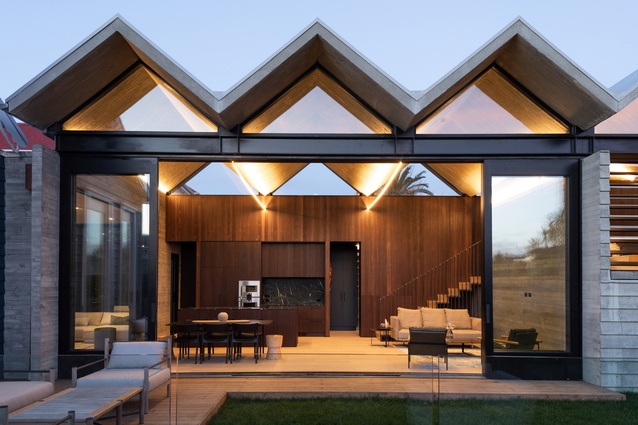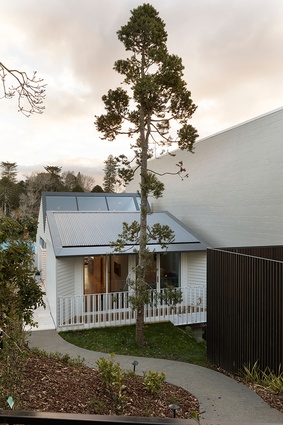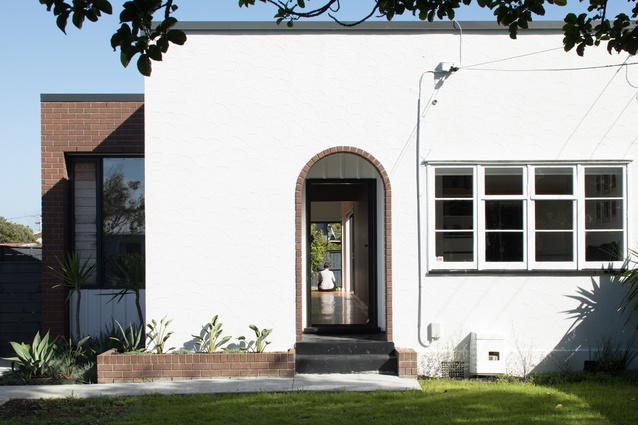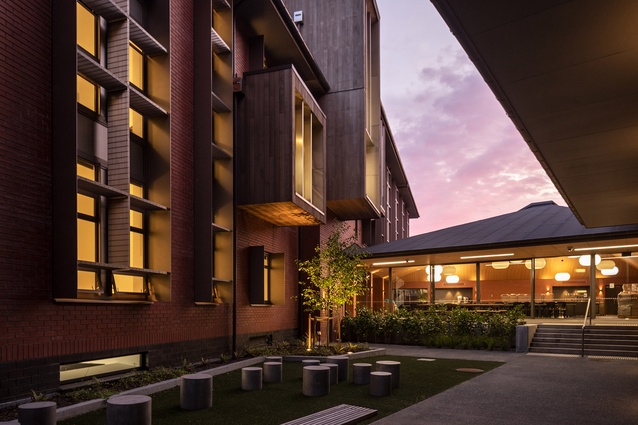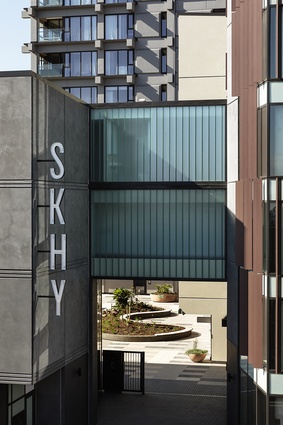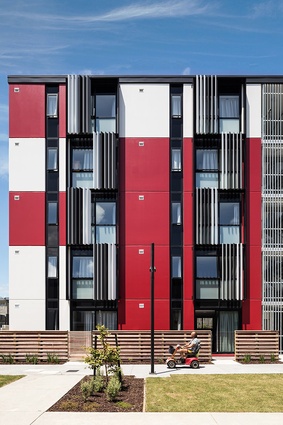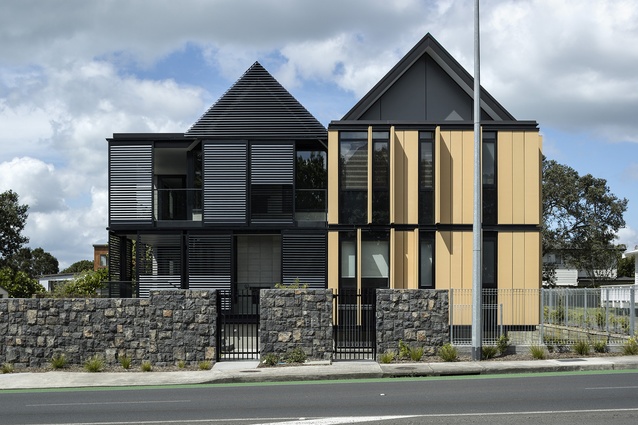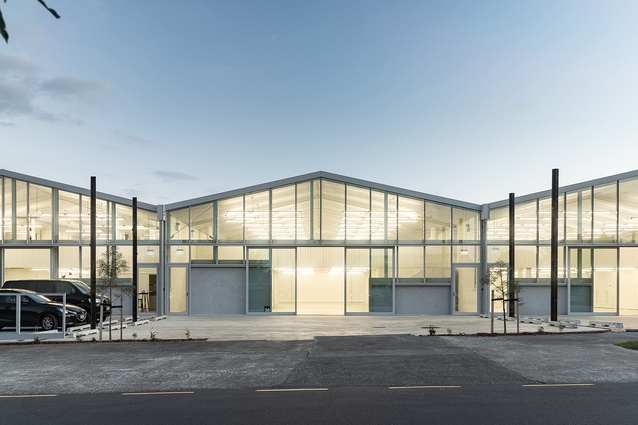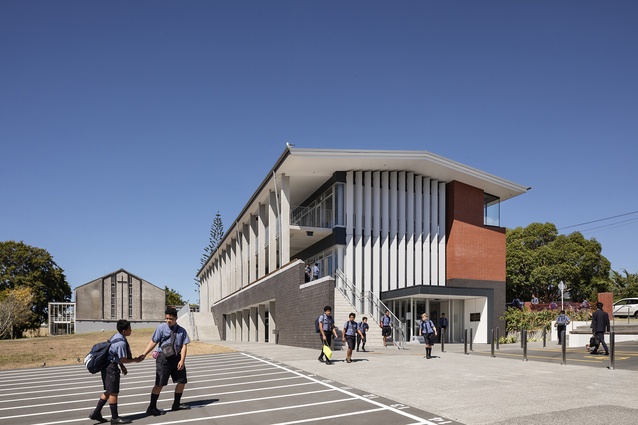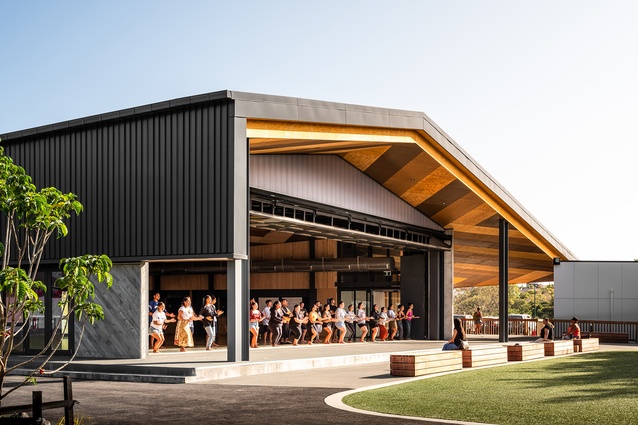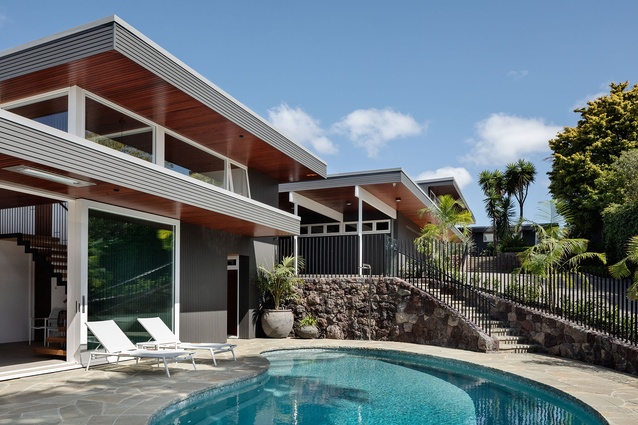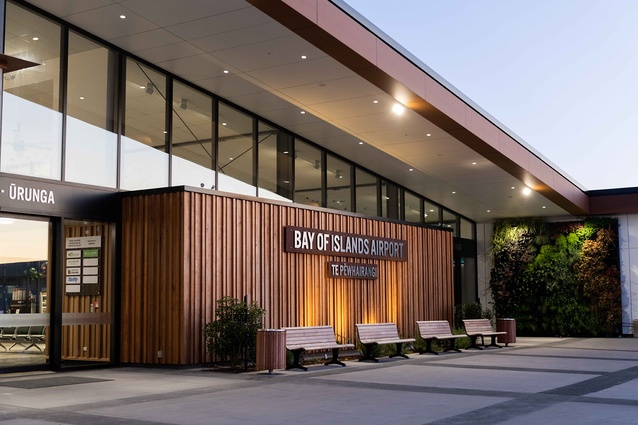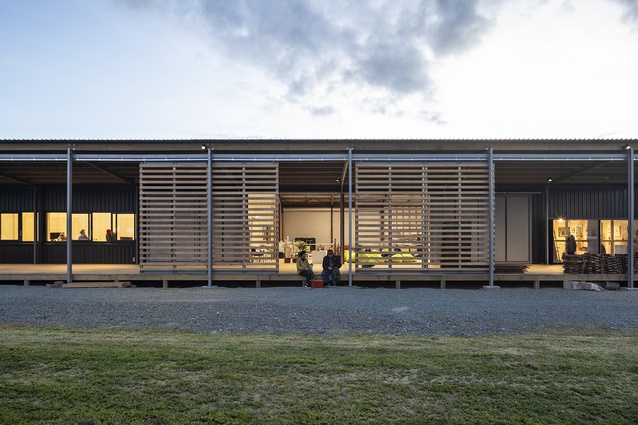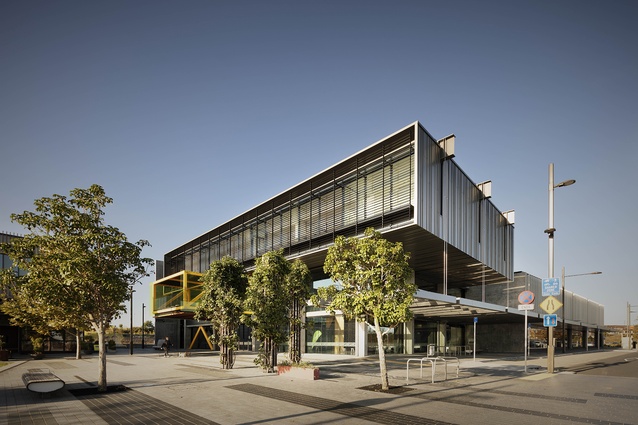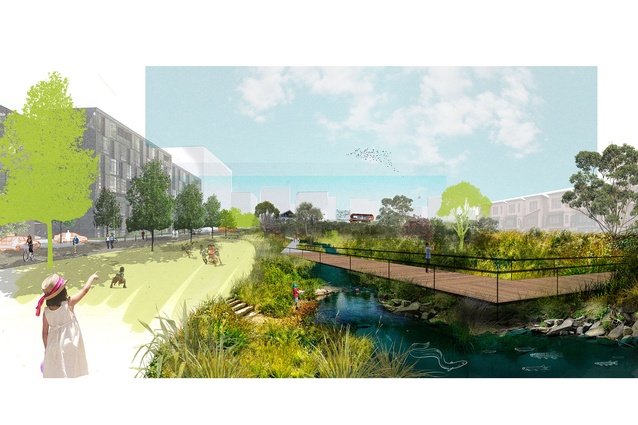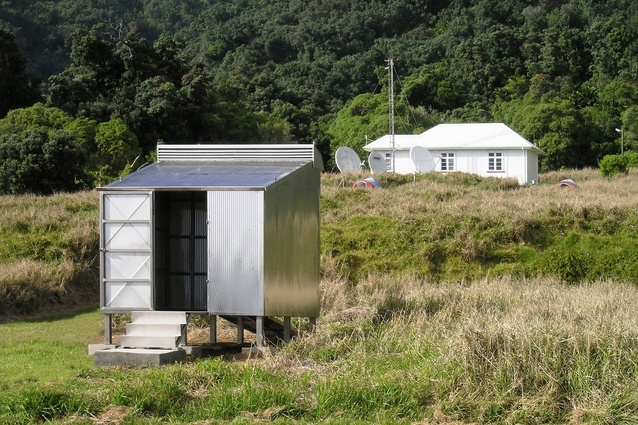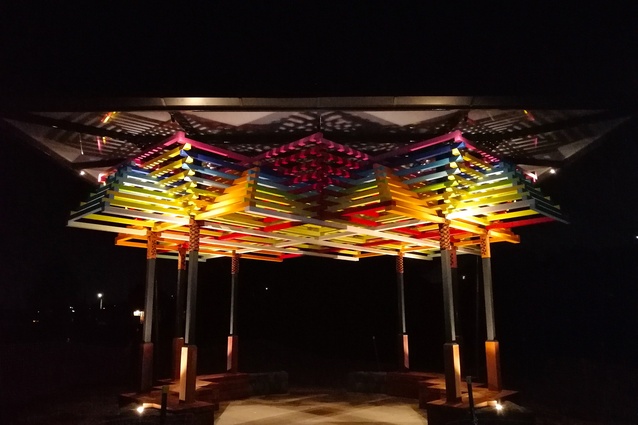Winners revealed: Auckland Architecture Awards 2020
The Auckland region saw 44 winners named in this year’s peer-reviewed local awards, run by Te Kāhui Whaihanga New Zealand Institute of Architects. The Auckland branch represents work from around the Auckland region as well as Northland.
This year’s winners included warehouse conversions, clever rooflines, welcoming community spaces and much more. The jury was led by Jane Aimer, who was joined on the judging panel by fellow Auckland architects Nicholas Dalton and Eva Nash, Wellington architect Stuart Gardyne and broadcaster Eric Young.
Aimer noted, “We were impressed and encouraged by the dedication and care taken by architects to create sustainable, healthy and beautiful buildings, fit for purpose and appropriate to their physical and cultural contexts.”
See the full list of winners and jury citations below:
Housing
#3 by Studio2 Architects
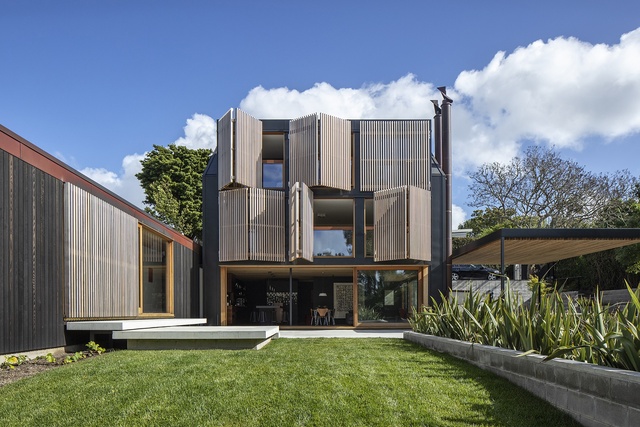
This is a thoroughly livable house that sits confidently in its secluded garden environment. A three-level tower is grounded into the site and paired with a single-level pavilion that extends into a parklike setting. All rooms and spaces have a unique character, and qualities that reflect their function. High-quality materials and elegant details are deployed to good effect in developing a contemporary family house influenced by a mid-century style. This is an exuberant and special house that perfectly balances habitation, craft and aesthetics.
Bowden House by Belinda George Architects and Mandeno Design in association
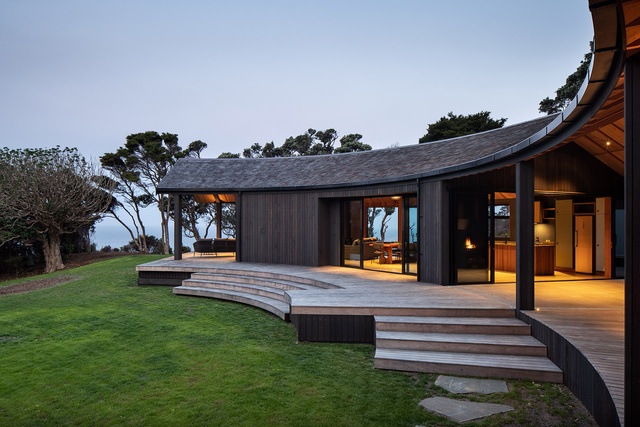
This stunning cedar-clad house is an outstanding project. The semi-circular plan nestles into the site, and the curved form conveys a sense of spatial coherence. The house’s natural rhythm allows for spaces that connect with each other, and the environment. The material palette is beautifully resolved and perfectly articulated to fit the crescent moon shape.
Parekura Bay House by Bossley Architects

Exposed concrete frames define this remote Bay of Islands home nestled into regenerated native planting. Responding to the client’s brief, the striking structure is composed of pre-cast concrete frames, creating a rhythm that articulates the mass and gives a nod to the Brutalist tradition. The frames are successfully expressed on both the interior and exterior of the three separate pavilions that follow the contour of the site. Environmental design principles have been well considered throughout and their influence is evident in a house with elongated floor plans, cross-ventilation, high- and low-level glazing, and substantial roof overhangs.
Lovers Leap by Bull O’Sullivan Architecture

This legacy project for one of the earliest Pakeha families in the district, whose ancestor signed the Treaty of Waitangi in 1840, replaces the original hilltop homestead with its generations of accumulated memories. The new whare, ‘Lovers Leap’, is appropriately austere in its materiality, given its rural location, and pragmatic in its intent; there are lots of areas to kick off the gumboots. The courtyard off the back of the kitchen – not a stereotypical design move – offers shelter from the wind and a place for intimate kōrero. The warm hues of the walls suit the art works of the owners. In sum, this house is a simple and robust delight.
Takatu Ridge House by D Ross Brown: Rosso Design
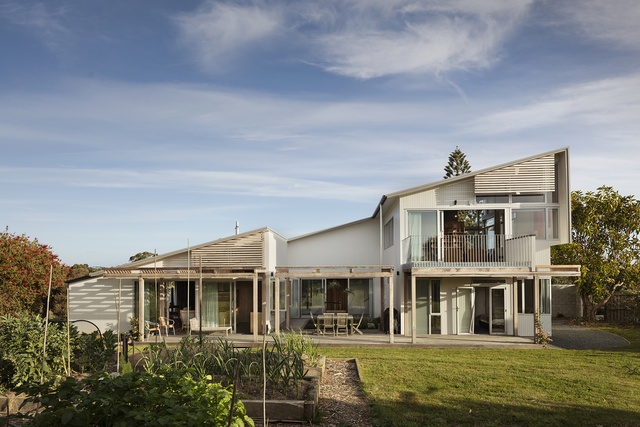
This is a calm and very livable house that enjoys a beneficial relationship with the garden, the broader site and the wider landscape. Planned around an intimate courtyard, the house has two wings that provide spatial complexity, natural light and advantageous views. An elevated study and living space, which gets the evening sun and long views to the west, creates a strong profile to the house that belies its modesty. The house is a mature project which demonstrates the benefits of design restraint.
Taumata Beach House by Fearon Hay Architects

This relaxed, low-key beach side encampment focuses on an experiential relationship with the site and wider environment. Three pavilions are configured around a private and sheltered courtyard, and balance views of the sea and privacy from the beach and public pathway. A muted, soft, neutral palette of durable materials establishes a calm house with equal attention given to interior and exterior spaces, while screens, doors and roof overhangs blur the boundary between the two. The house is a sophisticated project which is all the stronger for its avoidance of show.
Tutukaka House by Herbst Architects

Once again, Herbst Architects have delivered a well-considered and exquisitely crafted house by the sea, in this case a home surrounded by pastoral land and pockets of native bush with a stunning view towards the Poor Knights Islands. The use of rammed earth construction to anchor both ends of the building contrasts with a lightly-touching-the-earth verandah-like structure spanning between them. Beautifully detailed timber interiors and a visible and coherent structure blur the line between inside and out in a small house that provides admirable comfort and delight.
Waiheke by Patterson Associates
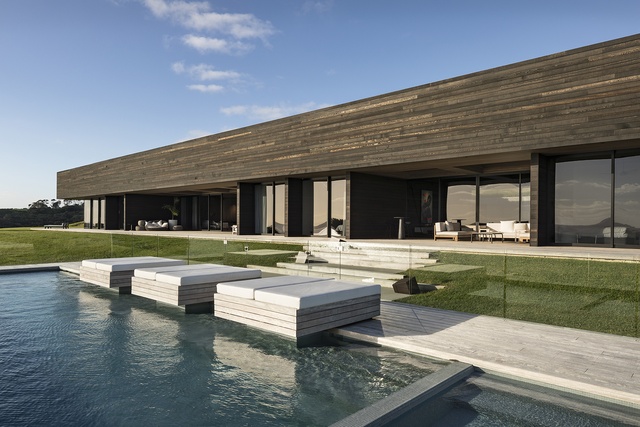
This dramatic form stretches across a breath-taking Waiheke site. The deep cedar-clad roof, which seems to float above glazed walls, expresses the house’s horizontality. The rectangular plan and the house’s striking form provide spaces to live together or apart, be exposed or sheltered, reside in dark or light. The grand sense of scale is designed to suit highly social clients.
Buckleton’s Boat Shed by RTA Studio
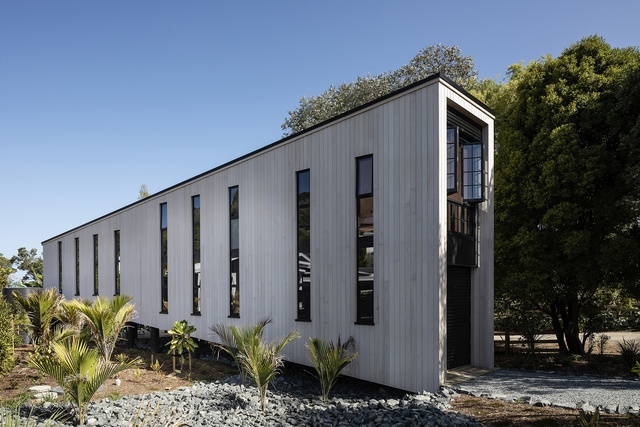
The house is an expression of fast and playful architecture that does not dwell on concerns about full resolution. The design was whipped up quickly, seemingly – but of course not actually – with the naivety of a student project. The architect cleverly saw the potential of a challenging site facing south and sitting in a floodplain, and created an elevated form that incorporates a vertical rectangular north elevation that twists to become a horizontal rectangular south elevation. Apparently unsophisticated and even cartoonish windows add to an appropriate level of casualness and informality. The design is an antidote to the obsessively overworked beach-house.
Reef House by SGA – Strachan Group Architects
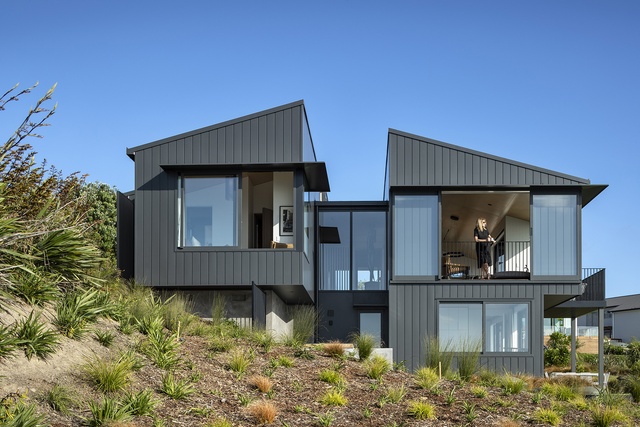
The Reef House brief was for a family holiday home for a mother and her three adult sons and their anticipated families. The site has extensive sea views, and the cruciform plan provides axial views and cross- ventilation, as well as a signature SGA ‘climate adjusting’ space, a low-tech, high-yield means for equalising temperature and humidity. Effectively an outdoor area, this space, with its three enclosed walls giving shelter to selected planting, captures the cross-ventilated winds and mitigates humidity over the peak of summer. The house is a series of carefully planned indoor and outdoor articulated rooms, each having well-placed windows to capture different vistas as well as offering wall space for the client’s extensive art collection. Special mention should go the client’s two sons who were apprentice builders on the project, and recently registered Architect Hana Scott who led the project admirably on site.
Parnell House by Stevens Lawson Architects
This finely crafted home carefully uses concrete, black brick and cedar to provide drama and sculptural impact to the street façade. The fluid planning has created moments of delight, such as the circular stair and music room. Cabinetry is seamlessly woven into the architecture, and the interior spaces feature the playful use of oak rounds which hark back to the circular motif in the plan; these organic forms create moments of delightful spatial layering. Of particular note is the double-height void which establishes a sense of rhythm throughout the space.
Housing – Alterations and Additions
Takapuna Alteration by Guy Tarrant Architects
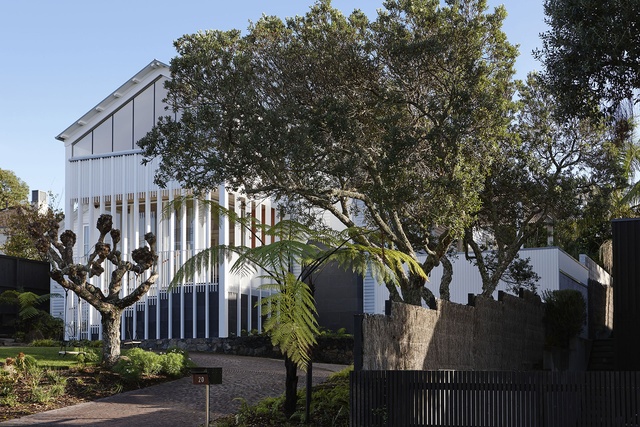
Originally a bungalow, then the recipient of a post-Modern make-over, this house has now been deftly taken in hand by Guy Tarrant. A simple gable roof with dormer extensions and a newly articulated front entrance and face to the street have restored dignity and coherence to the building. On a tight site, the architect has shoehorned in a comfortable outdoor living space and a small pool hard against two boundaries and established an easy connection between inside and out. While accommodating a brief requiring more interior amenity, the architect has made a dramatic intervention to the stair and upper level circulation that floods the space with light and conveys a sense of lofty grandeur.
Poured Pleats by Jack McKinney Architects
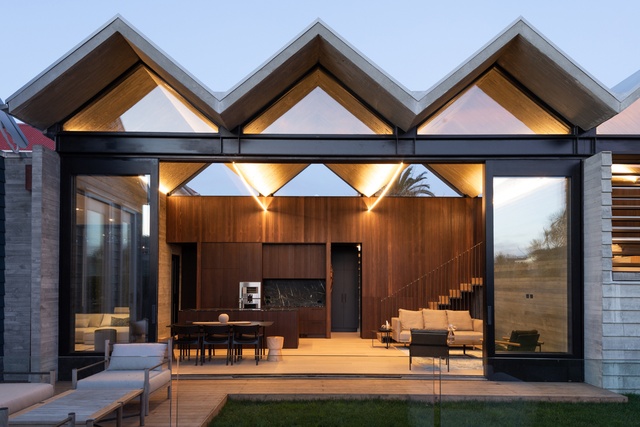
A double-gable form has been re-interpreted with striking effect in this villa alteration to yield a dynamic renovation that sits in proportion to the house’s heritage neighbours. The concrete roof is a strong sculptural statement that floats above glazed walls to create a vibrant and light-filled living area, and the house’s materiality is enhanced by the use of clever lighting. This is a well-considered, playful and delightful alteration.
Sawtooth Apartment by Sayes Studio

This project is a masterclass in the use of a simple plan and section to achieve extraordinary spatial complexity. A V-groove cut into the gable admits light into the rooms and establishes an intriguing and original elevation. The impact of the skylights, and the natural light they draw into the apartment, is dramatic. Elsewhere, modest materials and colour choices are thoughtfully composed, while details complementing the angular form are integrated subtly in the apartment design.
Pete’s Place by Sayes Studio
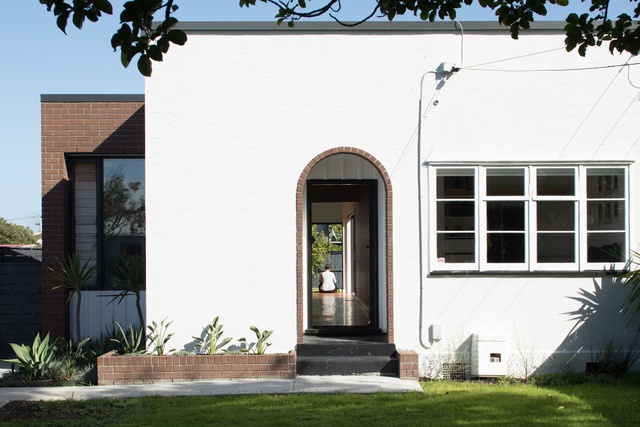
In this project, a tiny, semi-detached Art Deco house has been made into a grown-up dwelling. The clever use of cues from the existing house’s form and materials effortlessly transforms the building into a contemporary home with its own character. The transformation is only hinted at from the street in the new brick wing that references the archway of the porch. A clarity of planning and simple moves in section are handled efficiently and effectively. This is a perfect example of the balancing of old and new architecture.
Lean on Me by SGA – Strachan Group Architects
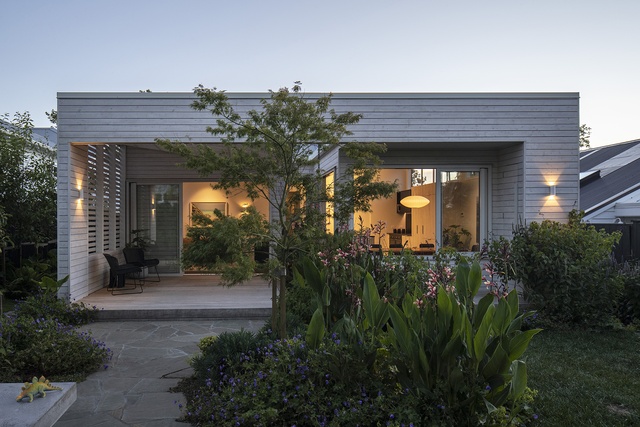
This is a clever addition that provides light-filled, relaxed spaces for the clients’ family. The original villa has been carefully restored to its glory and works in harmony with the new addition. The ‘lean-to’ is re-imagined as a semi-open plan living area, well-connected to the garden and outdoor living spaces. House and garden work in unison, and the outdoor room which forms an integral part of the plan is an essential component of family life.

Housing Multi-unit
Grafton Hall, The University of Auckland by Architectus
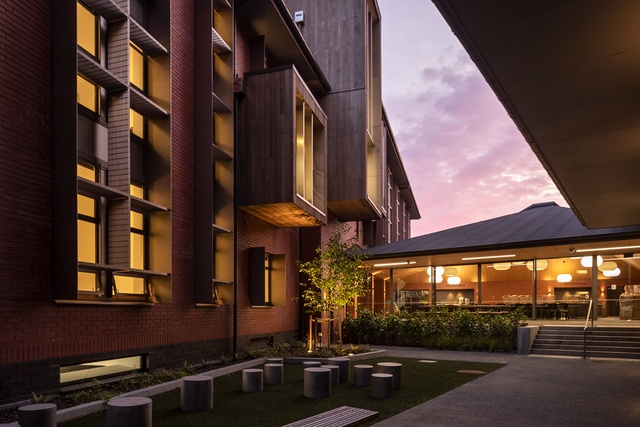
Student accommodation needs to be carefully planned: it can be lonely to be away from the comforts of home for the first time, but it’s also an exciting time, with opportunities to meet new people and enjoy new freedoms. On this site, students who were previously housed in a rather grim nine-storey tower are now dispersed around a series of low-rise blocks. Set amid generous landscaped spaces and sheltered courtyards, these buildings encourage easy social interaction as students move around and through the complex. A more domestic scale, ample natural light and ventilation, and well-planned and articulated access routes across the site help to create a sustainable community.
132 Halsey by Athfield Architects
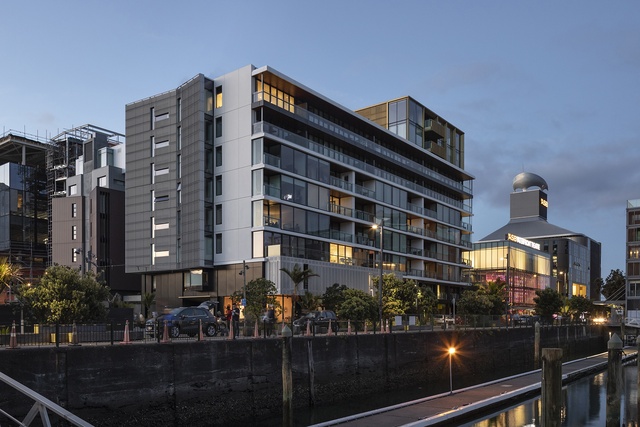
An elegant expression of the Wynyard Quarter Masterplan, this development explores a range of apartment typologies to provide for a diverse group of residents. The neighbourhood is enlivened by the variation in scale and materials across the three building types, and an expert manipulation of floor plans allows clear access paths and recognition of private areas within the apartments. Careful consideration of the street interface and the provision of publicly accessed through-routes will help to nourish a sustainable community, especially when ground-level tenancies are occupied.
SKHY by Cheshire Architects
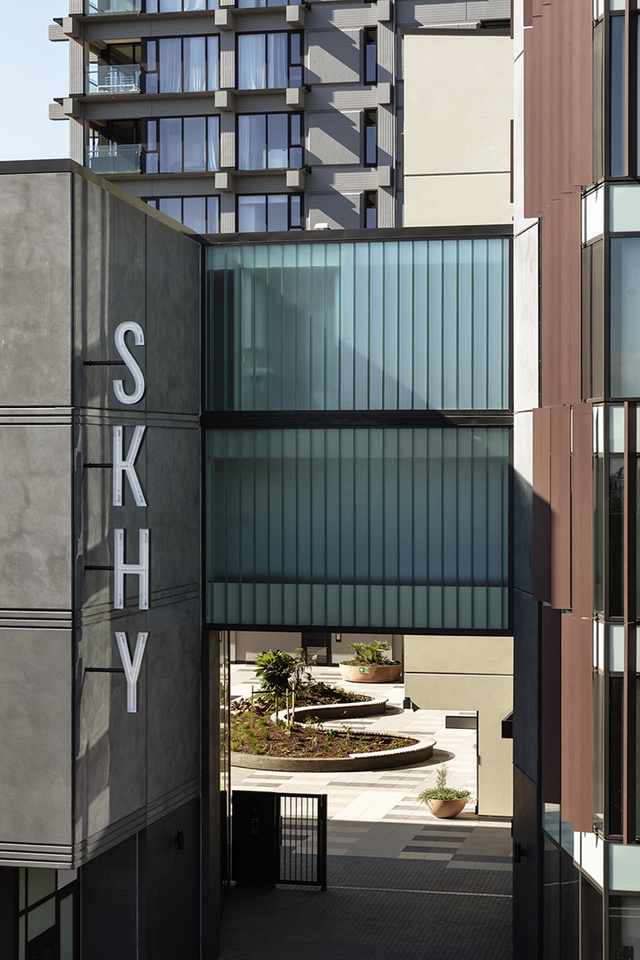
Set in uptown Tāmaki Makaurau, this urban renewal project is the ambitious conversion of an old mall post office and commercial tower into a modern industrial chic destination. Clever use has been made of the existing structure; parts of the concrete frame have been exposed, while spandrel panels which were causing decay in the original building were removed. The apartment plans use the existing structural bays to full advantage; central bathroom and kitchen pods divide the living areas and give the apartments a generous and luxurious feel. Stage One of this project – the conversion of the existing tower – gave a pronounced uplift to what was a very tired part of the city. Stage Two – more apartments over commercial spaces which open to a landscaped courtyard – is now complete, making this neighbourhood a proud address once more.
Royal Oak Housing Community, Auckland for the Salvation Army by Designgroup Stapleton Elliott
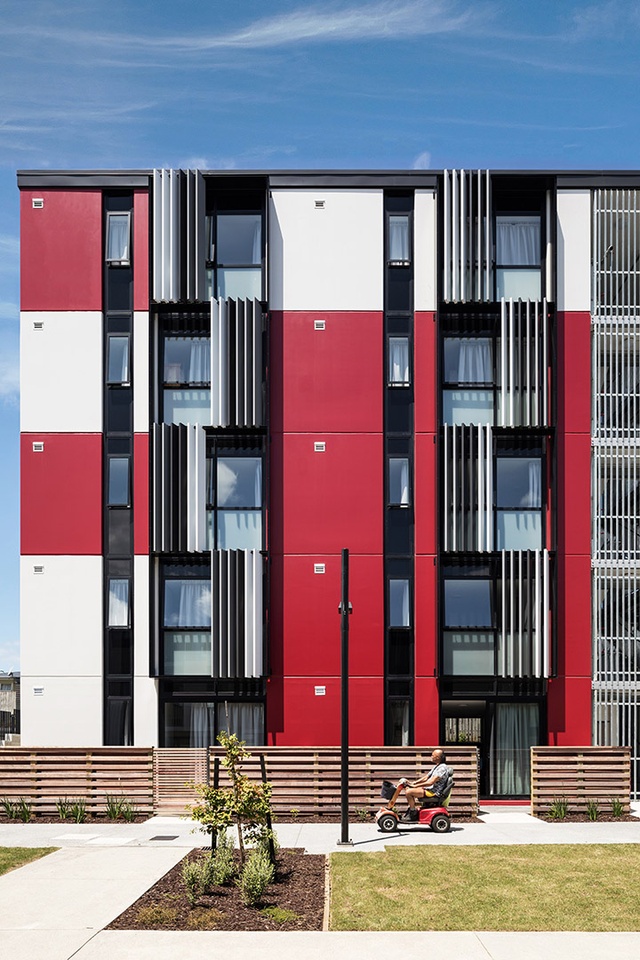
The architects have drawn on a body of social housing work to create thoroughly decent homes that exceed functional and aesthetic expectations for this housing type. Simply yet beautifully composed and articulated façades utilise solid, open and screen elements, and well-chosen colours. Well-configured and -considered communal open space is key to the site planning, the achievement of a high level of amenity and establishment of a sense of community.
Resene Colour Award
Colour has been used as an integral element in a composition of material, textures and forms, and individual buildings are primarily identified by bold colours.
Napier Lane Apartments by JWA Architects
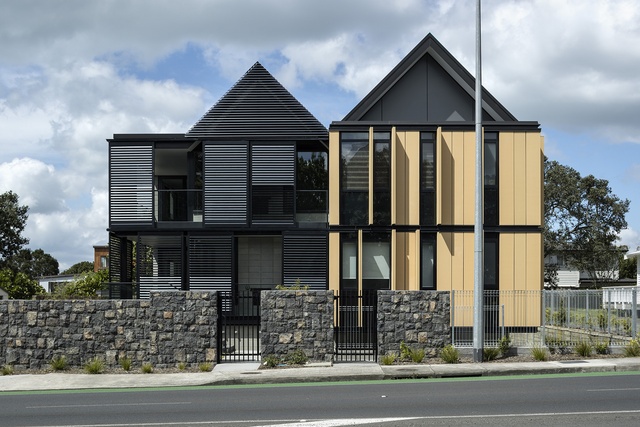
Squeezed between a busy intersection and residential houses, this project makes good use of a tight site. The project has been carefully considered and planned into two apartments, one above the other; from the street the building appears as two gable forms, with materials carefully selected to break down the mass, rendering it proportional to residential neighbours. The scale and materiality of the apartment building helps it sit harmoniously within its context, and privacy and outdoor spaces have been well handled to produce apartments that are a delight to inhabit.
The Grounds by Peddle Thorp
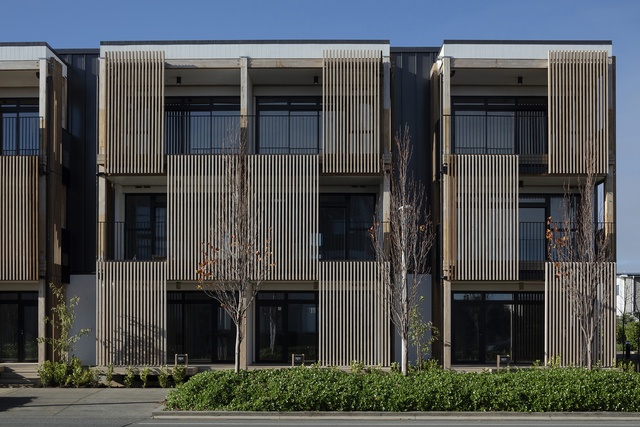
Among the many similar looking multi-unit housing projects at Hobsonville, the Grounds stands out for its clarity of form, expert articulation of materials and elegantly realised interior and exterior spaces. The architects’ exploration of cost-effective modular construction suggests a passion for detailing well beyond the usual pragmatic approach. Apartments have generous exterior living spaces and have been given privacy and shelter through carefully placed screens. The ambition for the project was ‘to create an innovative example of the benefits of mass-engineered timber construction through design, construction and the projected life cycle of the building’, and this goal has been realised.
Commercial Architecture
Sunderland Hangar at Catalina Bay by Cheshire Architects and Ignite Architects
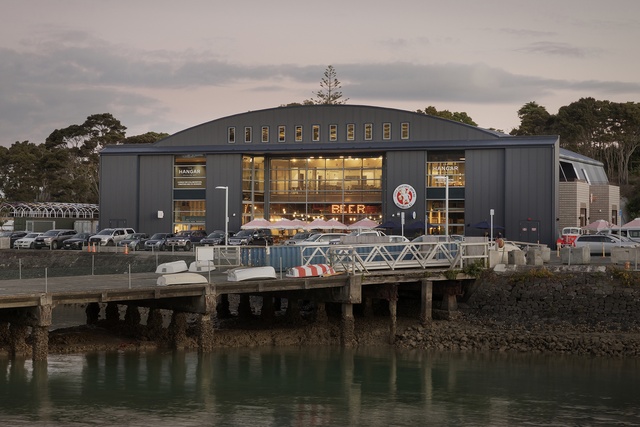
It must have been tempting for the developers of the Catalina Bay precinct to simply demolish this disused and dilapidated hangar at the seaplane landing site. Luckily for the new Hobsonsville Point suburb, with its rows of new housing and raw landscaping, the commitment was made to rebuild the hangar, re-using its materials, in order to bring a much-needed sense of history to the developing waterside neighbourhood. The original structure has been lovingly restored and references to the old hangar abound; long may the building serve as a popular hang-out for the locals and as a means of encouraging a sustainable and vibrant community.
Fabric Warehouse 2 by Fearon Hay Architects
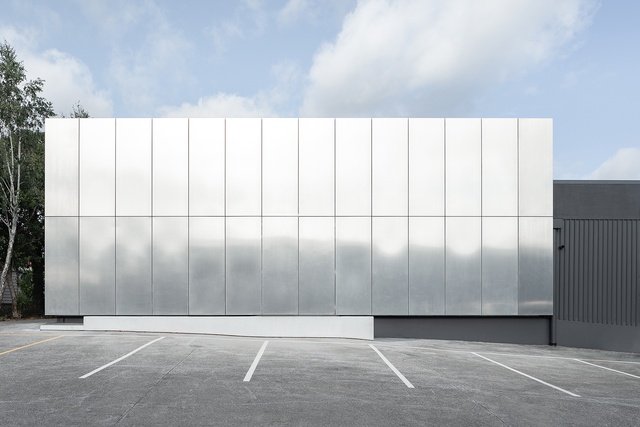
This modern insertion into an existing building has transformed a street-front façade which gives no clue to what lies beyond: a striking, light-filled office space. The open plan workspaces assume the character of a lofty art gallery in order to showcase the client’s art and objects. Integrated courtyards further enhance the workspace, allowing flexibility of space for daily activities or larger events. Environmental considerations are evident in the use of solar panels to reduce the building’s reliance on the national grid.
Ethel Street Warehouses by Fearon Hay Architects
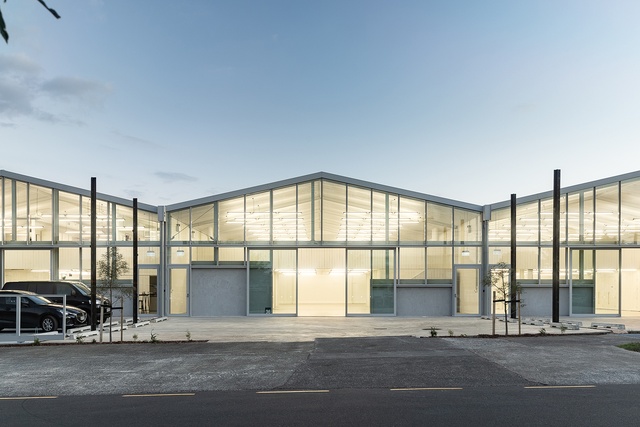
A silk purse from a sow’s ear: in this project, the architects saw the potential of a simple row of steel-trussed warehouses hiding behind a series of banal office sheds. The revealing of these spaces and addition of elegant façades composed of new glazing and existing concrete panels has resulted in desirable tenancies for multiple uses. Within the interior, mezzanines that stop short of the perimeter allow the generous scale of the original volume to be experienced. A carefully designed carparking forecourt offers opportunities for tenants to hold external events.
17 Landing Drive by JWA Architects
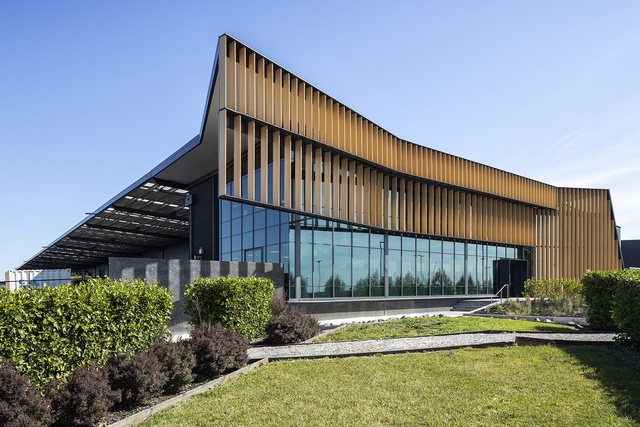
This exemplary project shows how a big box and small office can work in tandem to maximum effect with minimum effort. A process of clever integration has tied together the vertical elements of the office screen and horizontal elements of the warehouse canopy. The result is a bold, dynamic and sophisticated composition that reflects the scale and drama of the precinct’s landscape.
Resene Colour Award
A largely neutral palette of materials is lifted by a single bright yellow colour at the ends of the building.
Botany Toyota by Woodhams Meikle Zhan Architects

Occupying a prominent position in Botany this car sales and service facility has a light and delicate presence for a building of its size. The design is informed by the philosophy of the parent company, which expresses a commitment to environmental principles. Two large buildings, which are given warmth by the use of timber structural members and plywood linings, are split into separate volumes. These are linked by an elegant inverted ‘hipped roof’ porte-cochère which appears to hover over the intermediate space and creates a pleasant arrival experience. The subtle use of the client’s corporate red colour creates a shimmering effect on exterior cladding, punctuated with solid red accents around doorways.
Education
St. Paul’s College Marcellin Champagnat Building by Architectus
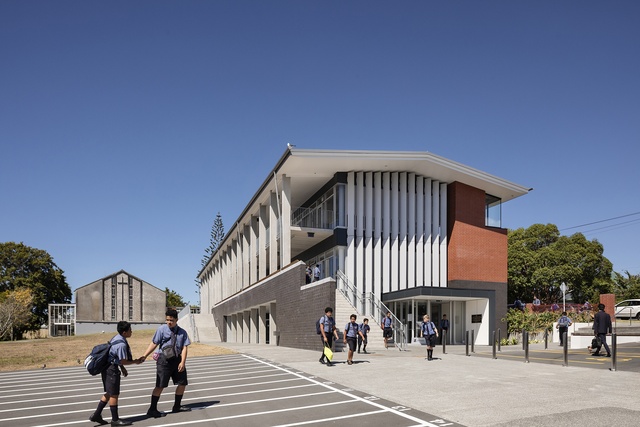
The building is the first stage of, and important start to the redevelopment of a school campus to create fit-for-purpose classrooms and administration facilities. Sited in accordance with a masterplan that addresses urban conditions and envisages connected open spaces, the building simply and effectively negotiates site levels, and is configured and articulated to acknowledge the road to the south, the chapel to the east, classrooms and arrival area to the west and playgrounds to the north. Robust materials and a restrained aesthetic imbue the building with a strong yet subdued presence that will allow it to sit well on the street and in the campus for years to come.
Dilworth Junior Campus Sports Centre by GHDWoodhead creativespaces
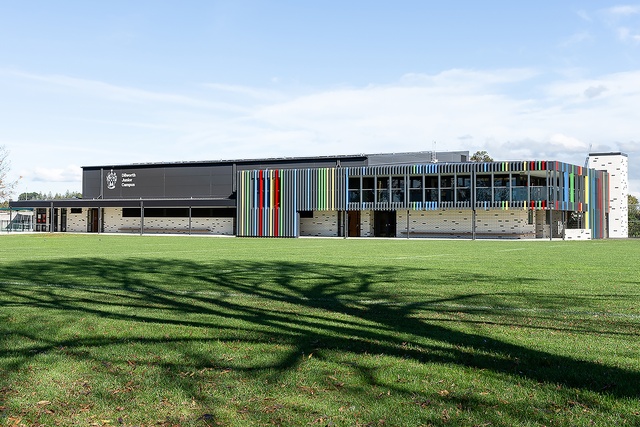
This joyfully coloured sports centre, squeezed between a motorway and the school’s rugby fields, has a more playful presence than one might expect from this type of building. Background colours and materials co-exist happily with the existing school buildings. The composition is enlivened by the bright colours of the screen walls representing the school’s House colours, with additional coloured lighting used to celebrate House milestones and achievements. Careful consideration has been given to creating a sustainable environment, through the use of natural lighting, passive ventilation systems and photovoltaic cells to supply the building’s energy requirements.

This complex building makes a point of celebrating its function. Behind the exuberant and colourful clothing of the façade and fit-out is a thoroughly resolved and simple skeleton of structure and services that is revealed to offer students a transparent and educational exhibit. A very adaptable and flexible plan and section provide the faculty with a highly adaptable facility, and materials, colour and detailing internally and externally show an awareness of how an institutional building can offer delight to its youthful occupants.
Resene Colour Award
The lively, bold and extensive use of colour has been incorporated in a manner that expresses functionality and makes it evident that students are the primary occupants of the building.
Western Springs College Ngā Puna O Waiōrea Redevelopment by Jasmax
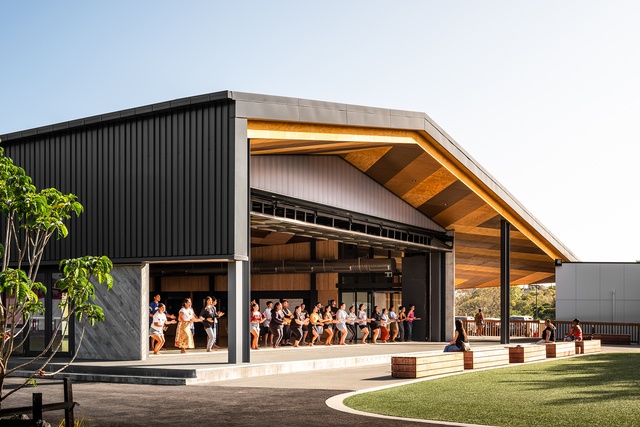
This project involved a massive overhaul of a tired campus overburdened with relocatable classrooms and car-dominated courtyard spaces. The architects’ first transformational move was the development of a school masterplan that prioritised the students, making the connections between the buildings almost entirely pedestrian focused. The two new teaching blocks impart a contemporary university sensibility to the campus. One of the blocks, housing the jewel in the school’s crown, Ngā Puna o Waiōrea, the college’s Māori immersion-Rumaki unit, is the product of a collaboration with local mana whenua artist Graham Tipene, whose knowledge of the whakapapa of the area was applied to the creation of integrated art pieces. The almost aircraft hangar-sized opening to a capacious kapa haka stage is a sight to behold. The school’s transformational results in both student attendance and academic achievement are testament to the quality of the new campus, and the pride it has engendered in students and the wider community.
Hospitality
Kind Café by Edwards White Architects
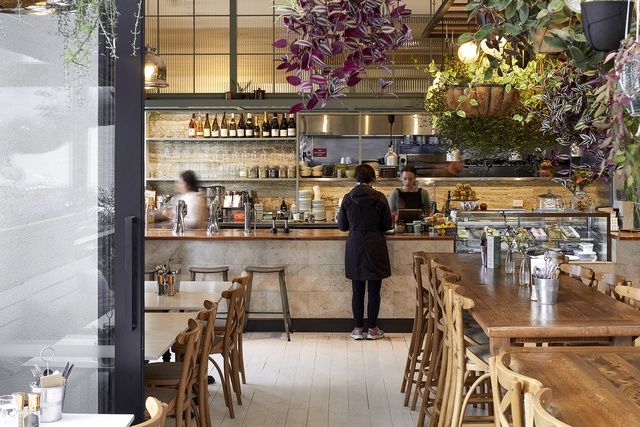
Kind Café sits on a busy corner site in what had been a rather grim area of Morningside. Lush greenery and hanging baskets add vibrant splashes of colour to a grey, semi-industrial neighbourhood and provide dappled shade under the greenhouse roof. The junction of inside and outside spaces is blurred and, wherever you sit, the café is an engaging and delightful space to inhabit. There is a commendable commitment to sustainability, with community composting and the conversion of the local disused bowling club to a produce garden. In sum, the café is a vibrant addition to a previously neglected suburb.
Interior Architecture
Private Office by Bureaux

This is impressive office fit-out exhibits a keen attention to detail. The sophisticated material palette has been precisely considered from the ‘acoustic artwork’ to the ‘metal curtains’, and the project has resulted in a space that is beautifully resolved and perfectly articulated, and which should prove to be of enduring value.
Heritage
Lucerne House by Godward Guthrie Architecture
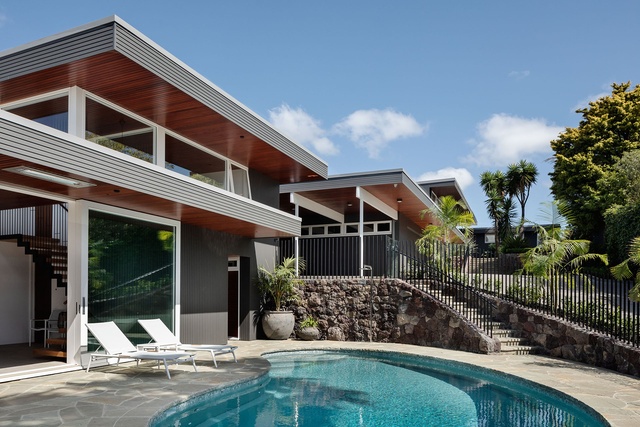
In this thoughtful and well-considered restoration of a Vladimir Cacala house, impressive attention has been paid to detail in restoring original features and respecting the intentions of the original architect. The new detached pool house has been sympathetically designed to pay tribute to the original house, to the extent that it is hard to distinguish new from old.
Public Architecture
Bay of Islands Airport by Eclipse Architecture
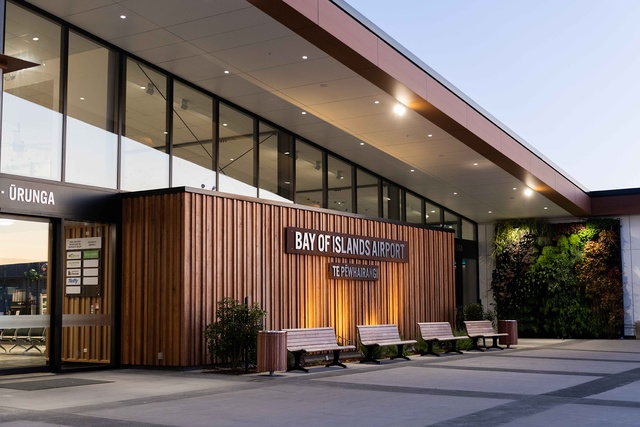
The Bay of Islands Airport is a gateway to the North, and not far from Waitangi, the birthplace of our nation. This project took a very challenging brief – which changed, along with its budget, many times – that sought to strike a balance between immediate needs and the anticipation of future growth. The architect diagrammed the flow of incoming and outgoing passengers and drew inspiration from the idea of an eddy to place a café in the centre of the two streams of passengers. The stratagem works and because it does, Bay of Islands Airport is one of the more successful regional airports. Artwork created by local mana whenua artists grounds the project and reflects its near-civic nature as an expression of manaakitanga, which is about being gracious hosts. The desire of architect and clients that the building should tell the stories of the local iwi is certainly worth celebrating. If you have not visited this part of Aotearoa, this airport is now an ideal gateway.
Hihiaua Cultural Centre by Moller Architects
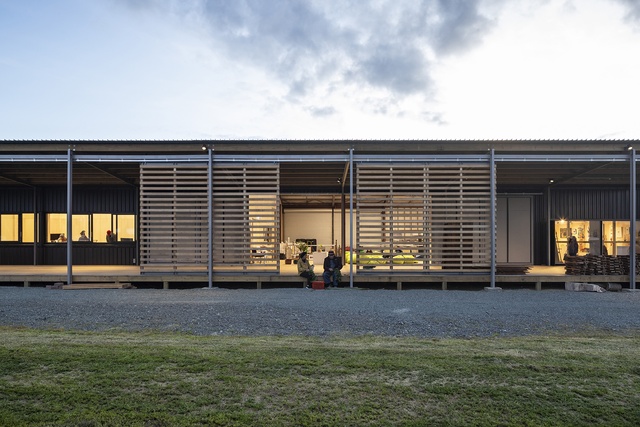
This cultural centre was delivered after a comprehensive co-design process with the community, an exercise that was integral in the realisation of a building used and valued by that community. A series of spaces break off a linear loggia or porch, raised slightly off the ground so that its edge can serve as a seat when, for example, people are engaged in weaving. Every centimetre of this centre is carefully designed and constructed. It’s not every day you get to design a building next to an awa, with a gantry which can, once a waka is carved, hoist it up and lower it into the river. This is a rich response with a meaningful ending. Tēnā rawa atu koe, Craig Moller, for this great piece of architecture.
The Chapel of St. Peter by Stevens Lawson Architects

This is a significant building, uplifting and inspirational. The carefully considered chapel has been meticulously designed to accord with and express the principles of the client school. The particular symbolic references to the saint after whom the school is named, are evident in the architecture, creating a resonant chapel for the college community. The building is profoundly spiritual and will serve the school and its community for decades to come.
Te Manawa Westgate Library and Multi-Purpose Facility by Warren and Mahoney Architects
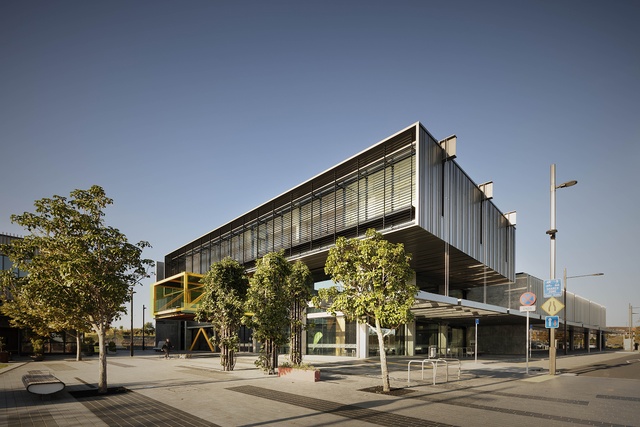
This confident, contemporary public building expresses the understanding of client and architect of the building’s role in responding to urban conditions and meeting community needs. In a challenging local authority environment that demands value for money, and within a physical environment that is largely retail, the building incorporates moments of intrigue and delight; it has generous spatial qualities, makes good use of natural light, deploys a sophisticated material palette, and communicates its purpose through a ‘stacked book’ effect articulated on the façade.
Planning and Urban Design
Tāmaki Precinct Masterplan by Studio Pacific Architecture

In producing this ambitious and comprehensive masterplan for the regeneration over the next 10-15 years of an area comprising three suburbs, the architects have demonstrated a sophisticated understanding of the scope of the project and the tools available for its realisation. The adoption of a ‘people first’ approach is a welcome development in New Zealand urban planning, and promises well for the achievement of the project’s goal of fostering the growth of strong, vibrant and resilient communities. In particular, the application of Te Aranga design principles is evidence of a commitment to shape a place to suit the people who live there.
Metlifecare Gulf Rise by Warren and Mahoney Architects

To challenge the stereotypical approach to the planning of retirement villages is no easy feat; it takes a brave architect and also a bold client to pull this off. In this case, credit must be given to architect and client for sticking to their determination to do things differently, and better. The result is a very grounded and community-based project, which seeks to prioritise people, rather than cars or profit. This design is deliberate and considered; it allows for public and private space, generous walking tracks, and most gratifyingly, gardens producing edible crops.
Small Project Architecture
In Context: RTA Studio Exhibition by Andrew Barrie Lab
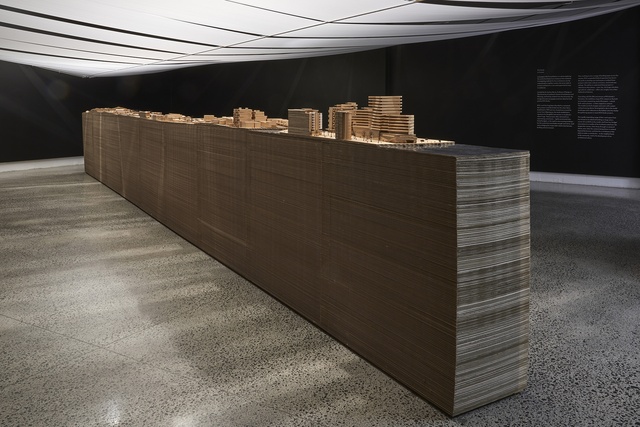
This was a carefully considered temporary installation precisely put together by a dedicated team. Thorough planning was given to every element and craftsmanship was shown in every component, including the impressive model base, 35 perfectly made projects, and a delicate paper ceiling. The life cycle of every exhibition component was well thought-out, resulting in only a handful of residual items after the project was disassembled.
Raoul Hut by Bull O’Sullivan Architecture

The original commission called for the design of a weather station to be installed on remote Raoul Island in the Kermadecs, and was met with the response from the architects, ‘Can we build and install it?’. After a careful design process which included ensuring the structure could withstand the sulphuric environment as well as winds of 250 kilometres per hour, this small and complex design was shipped over with the architect, his son and an academic to the island by the New Zealand Navy. Simple concrete footings, welded stainless superstructure and a stainless-steel skin will ensure this vital piece of weather monitoring equipment lasts for decades to come.
Te Auaunga Awa – Multicultural Fāle & Outdoor Classroom by McCoy + Heine Architects
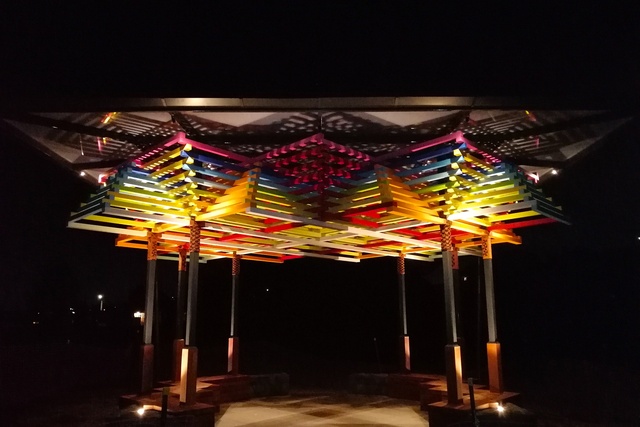
This garden intervention is heroic in its desire to connect people and place, and in its ambition of creating a space in which to relax and reflect. The project is a homage to Tāmaki Makaurau as the capital of the Polynesian world, home to Pacifica communities who have lived and worked locally for decades. An integrated artwork in collaboration with artist Sopolemalama Filipe Tohi resulted in the creation of the diverse elements of the design, from the folly overhead to the bespoke joinery seating. The project is wonderfully colourful and playful, but stoic, too, with its basalt walls.
Point Wells Cricket Club by Pac Studio
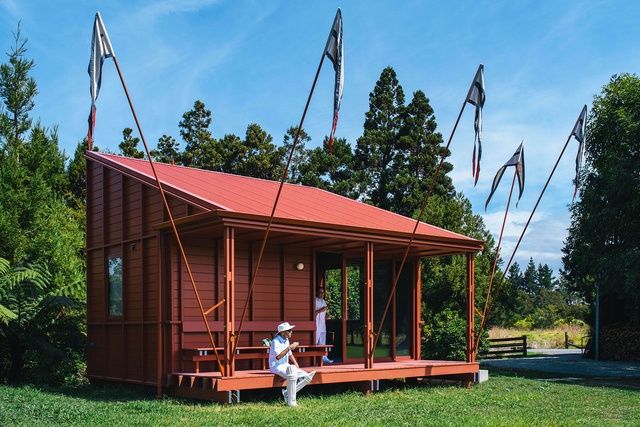
It would be hard not to be bowled over by this exuberant folly at the bottom of a private garden. Ostensibly the Point Wells cricket clubrooms, this nostalgically referenced elegant shed is a real labour of love. The architects have taken the brief for a small shelter to hold a beer fridge, and created at long on (or, depending at which end the batter is on strike, third man) an ode to the joy of watching cricket, complete with exaggerated flag poles and an old school wooden bench on the verandah, all designed to delight and amuse. Could this be the perfect man-shed?
Resene Colour Award
The bold red on the exterior says, ‘look at me’, and the cool blue on the interior promotes an escape from the hot summer sun.
The NZIA Local Awards programme has been supported by Resene for the last 30 years.

